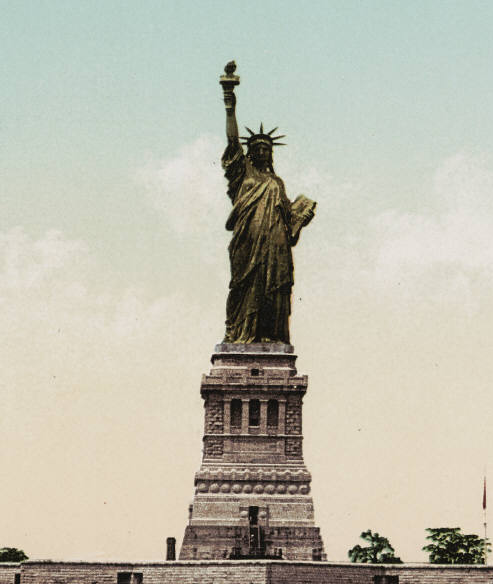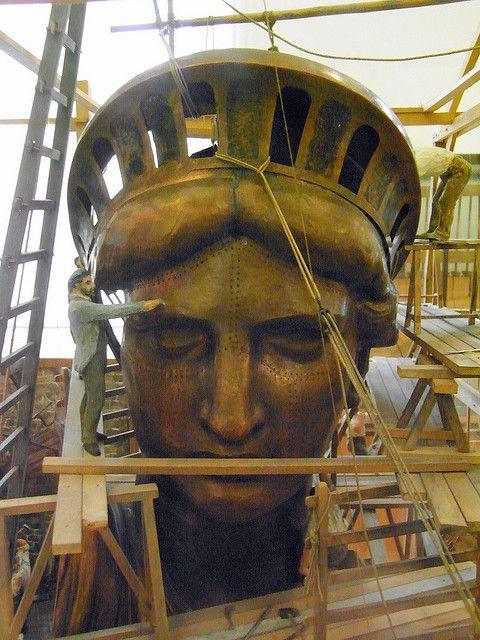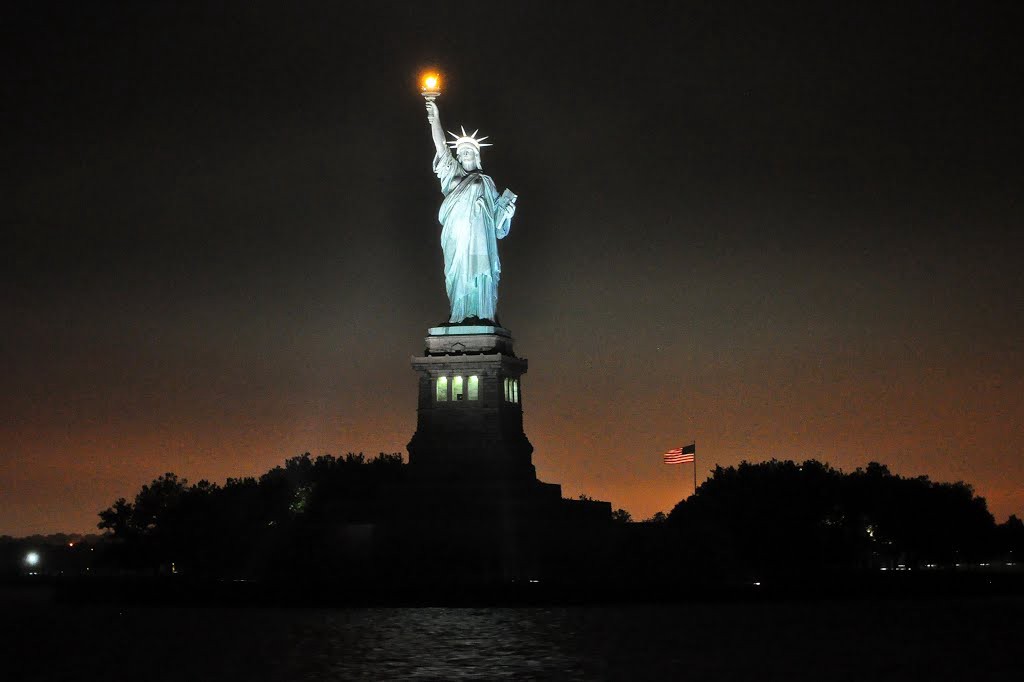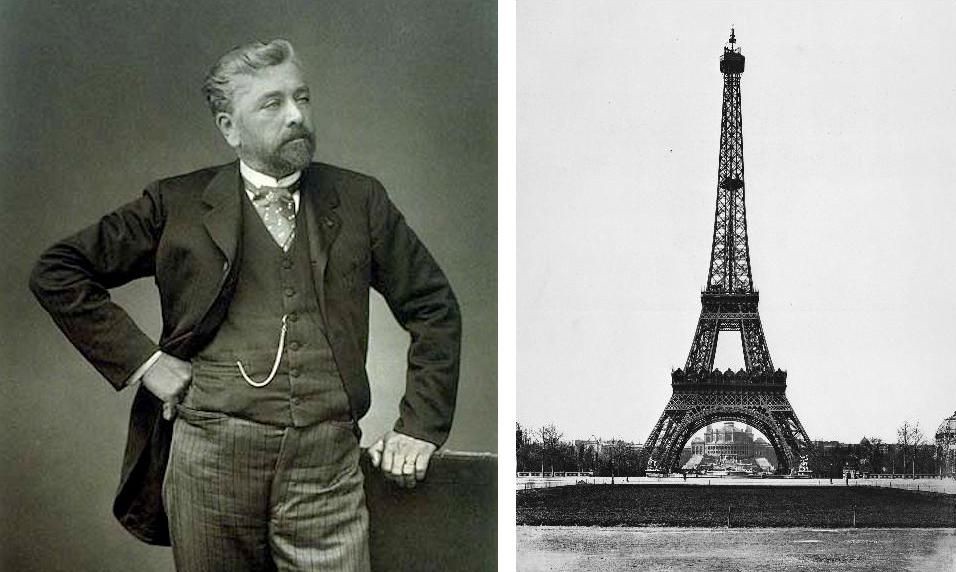WHY DOES COPPER TURN GREEN OVER TIME?
Copper naturally turns green over time as it reacts with oxygen in the air – a chemical reaction known as oxidation. The green colour is simply the natural shade of the patina that forms over the copper surface; the patina protects the copper from deterioration and creates a light bluish-green facade which can be seen on many copper rooftops and copper structures.

HOW LONG DOES IT TAKE COPPER TO TURN GREEN?
Copper doesn’t turn green overnight, it transitions through a number of stages over the years, moving from its initial orange shade into a dull brown colour, before finally settling into the familiar green tint.
To demonstrate the timescale of this transition, we’ve used the most famous and iconic example of this process on Earth: the Statue of Liberty. The animation below tracks its changing colour pallette over the months and years since it was first installed on what is now known as Liberty Island:
COPPER PATINA COLOUR CHART

The patina which forms over copper works to protect and preserve the underlying copper material. This is different to what happens to iron during oxidation, where rust forms over the surface, deteriorating the material over time.
From the Statue of Liberty to a commercial copper roof, the green patina prevents further oxidation, making copper one of the most long-lasting roofing materials you can find.
10 Secret Facts About Statue Of Liberty

Statue of Liberty in 1886 and 2018 (Credits: Dozr)
The statue of Liberty is one of the most famous monuments in the World. Anyone visiting New York city can see her, but not everyone knows the secrets of Lady Liberty. As a matter of fact, she might not be a Lady at all. Coming in hundreds of pieces as a gift from France, Lady Liberty became a remarkable landmark of rich historical value.
1. Lady Liberty Could Have Been Sir Liberty
Historians believe Auguste Bartholmodelledled Lady Liberty’s face on his brother’s face. Bartholdi’s brother was sick and spent most of his life hospitalized. Therefore, Bartholdi displayed his affection and respect for his brother by modelling Lady Liberty’s face. Others believe that Lady liberty’s face was modelled on Bartholdi’s mother’s face.
2. 350 pieces of Statue of Liberty
On June 17, 1885, the Statue of Liberty arrived as a gift from France to America in 350 copper and Iron pieces boxed in 214 crates at the New York City’s harbor. It came with an instruction manual. The scattered pieces turned out to be one of the World’s most iconic landmarks.
Lady Liberty’s arm and torch arrived a decade earlier than the rest of the body. In 1876, the arm and torch were put on display at Centennial Exposition in Philadelphia to raise funds to complete the statue’s building. Later, the arm was moved to Madison Square Park to generate further funds to complete Lady Liberty’s construction.
The rest of Lady Liberty’s statue arrived one decade later, in 1885. Each piece was collected and put together, secured by an iron framework and wooden beams. Lady Liberty’s inauguration was delayed from September to October 1886 because of the delicate, detailed construction process.

Lady Liberty in Paris.
3. History’s First Crowd-Funding Campaign
The U.S Government did not sponsor the Statue of Liberty. And instead, it was built on funds collected from the citizens through fundraising campaigns. Frederic Auguste Bartholdi raised funds in France first to build the statue. Once the statue was completed, Bartholdi offered it as a gift to the U.S on the condition that US was going to make its pedestal. The Federal Government disagreed. However, a newspaper magnate, Joseph Pulitzer, stepped in and raised massive crowd-funding campaigns to fund the construction. Pulitzer managed to collect funds from over 120,000 donors, the middle class constituting 80% of it.
4. Lady Liberty Turning Green

Statue of Liberty Changing colour over time (Credits: Dozr)
The Lady Liberty was not always green. The statue of Liberty was made from copper and iron hence giving it a prominent Copper color. The statue was in a shiny brown color when it first arrived in America from France. Over the years, the copper started to oxidize and gradually change color from brown to red to green. There was a time when the statue stood half copper and half green. By 1920, the statue had completely oxidized and turned green from the coats of Patina. It is believed the color will no longer change and stay as it is now.
5. The Lighthouse of New York City

(Credits: Abagond)
The statue was initially supposed to serve as a lighthouse for ships sailing under the New York Harbor. The statue of Liberty worked as a light house for 16 years. However, the light was not bright enough. Bartholdi deduced a solution for this problem and suggested Congress to cover the Lady Liberty in Gold. This way, it would reflect more light. However, Congress did not go through with the idea because it was too expensive.
6. Lady Liberty is Covered With Number 7
The Statue of Liberty has a special connection with the number 7. The Lady Liberty’s crown has seven spikes. Under these spikes, 25 windows make seven if you add five into 2. There are 16 leaves around the torch, and the monument itself is 151 feet, the sum of both the digits is 7. The number 7 is believed to represent the seven oceans and continents, which symbolizes divinity.
7. The Designer of the Eiffel Tower Engineered Lady Liberty’s Pedestal Support

Gustave Eiffel (Credits: Pintrest)
Alexandre Gustave Eiffel, a prominent French architect, designed the internal steel framework of the statue of Liberty to keep it stable during strong winds and rain. The figure is strong enough to withstand 600 lightning bolts a year. Lady Liberty sways 3 inches, and her torch sways 5 inches during high winds.
8. The Egyptian Version of Statue of Liberty
Auguste Bartholdi, the designer of Lady Liberty, was a freemason. It is believed that the Statue of Liberty was a symbol of freemasonry. Bartholdi wanted to make a similar statue for Egypt to be placed in Suez Canal, initially. However, Egypt did not have enough funds to support the construction. Bartholdi then decided to make few changes to the Egyptian statue and transform it into Lady Liberty that he gifted to America later. Lady Liberty’s torch is a symbolic representation of the “torch of enlightenment” or “flaming torch of reason” in freemasonry.
9. The Statue Represents the Roman Goddess
Lady Liberty’s name comes from the Roman deity, Libertas. The Roman Goddess Libertas was a representation of freedom. Libertas appeared on Roman coins since the era of Julius Caesar’s assassination to support the republic. Many historians believed that the Statue of Liberty was characterized as Libertas depicting freedom. They were also convinced that Lady Liberty’s face was modeled on Libertas face.
10. Three Original Statues of Liberty
 Statue of Liberty in France (Credits: Pennyvanderbilt)
Statue of Liberty in France (Credits: Pennyvanderbilt)
The Lady Liberty sits gracefully on the New York Harbour. Bartholdi made two other miniature statues of Liberty that are found in Paris. The first statue of Liberty is present in Jardin du Luxembourg, which was created to use as a visual aid for designing a bigger version of Lady Liberty. The other statue stands in Island of the swans, Ile aux Cygnes in the Seine River. It was made to pay homage to the French Revolution and American Independence.
References
“https://www.bbc.com/news/in-pictures-21947710”
“https://dozr.com/blog/building-the-statue-of-liberty/”
“https://www.historybyzim.com/2012/05/statue-of-liberty-1942/”
“https://www.exp1.com/blog/7-numbers-statue-of-liberty/”





